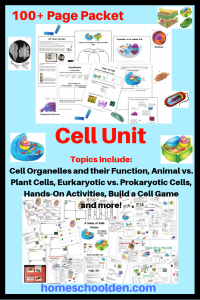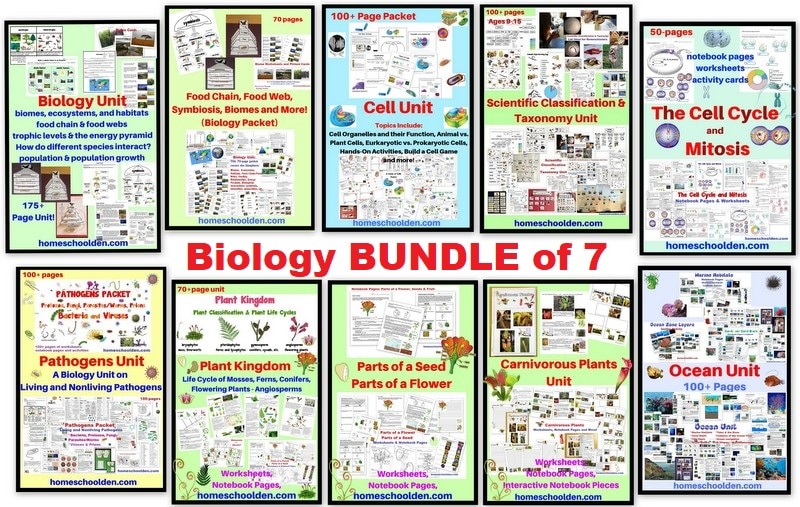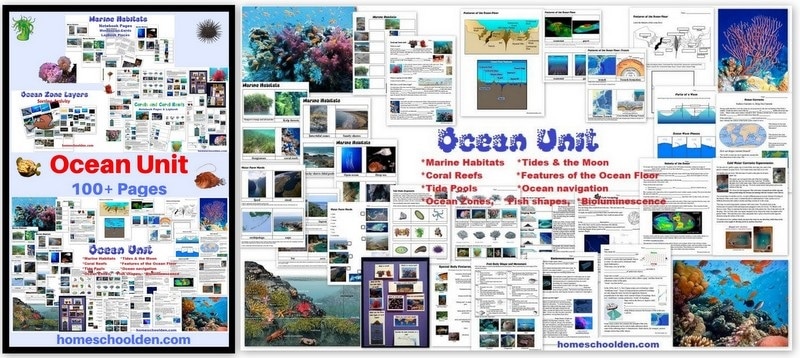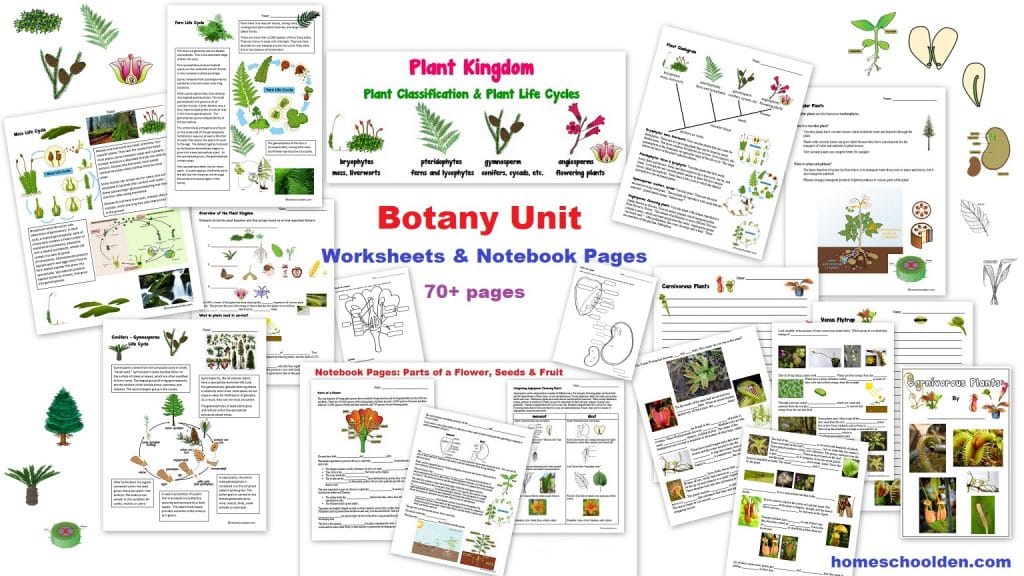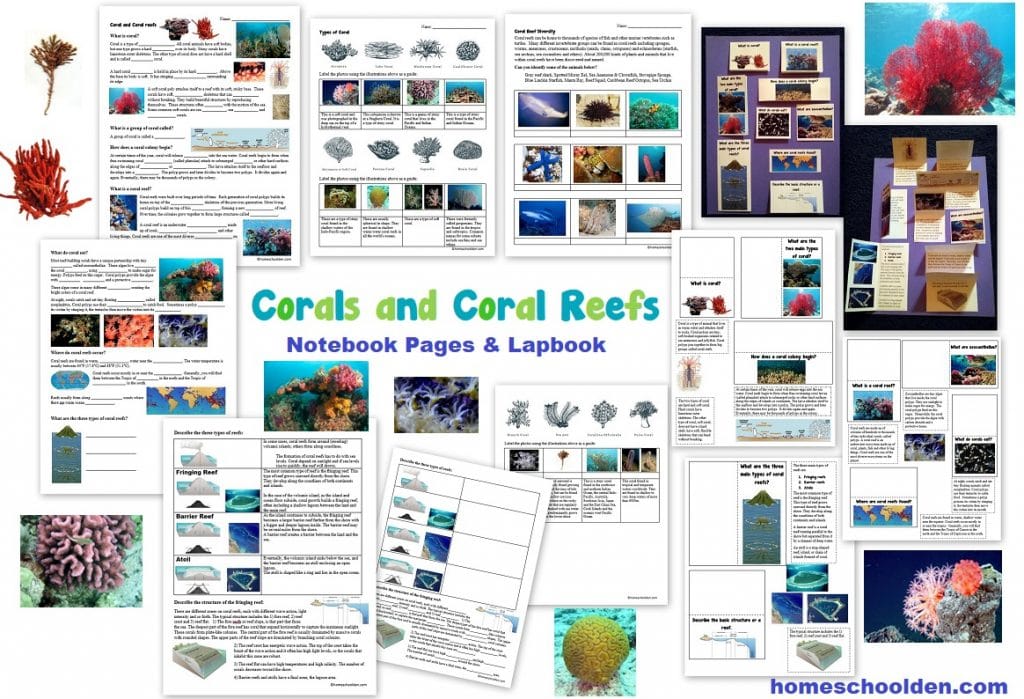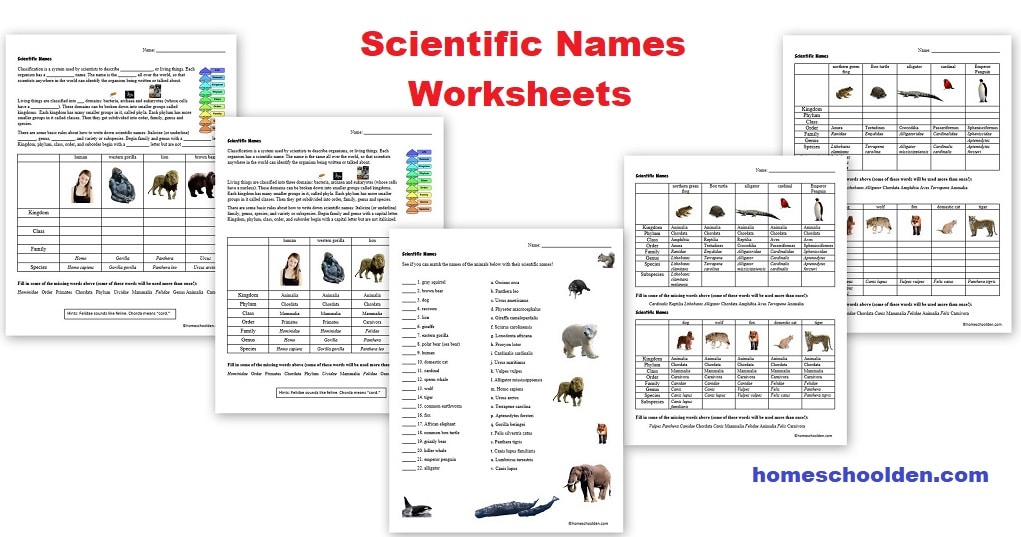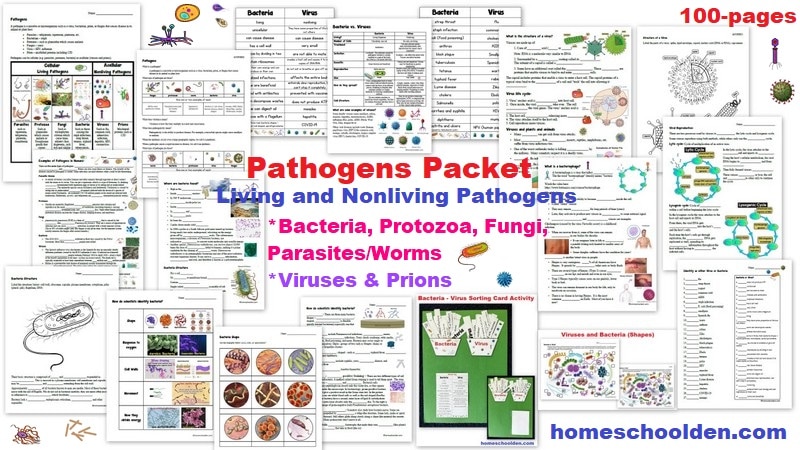Cell Packet Update! Cell Biology Unit – Organelles, Eukaryotic vs. Prokaryotic cells, Plant vs. Animal Cells and more!

- cell theory,
- prokaryotic vs. eukaryotic cells,
- animal vs. plant cells,
- the layers of a leaf,
- photosynthesis
and more!
My kids were 9 and 11 (and 7) when we first did this unit. We covered this again a couple years later and now my kids are 11, 13 and 15 (with these new updates). So, this Cell Unit can be used with a wide range of ages (just pick and choose what will work for your kids). That’s homeschool life for you, right?!


Our Cell Packet is now 100+ pages. It covers
- Cell theory
- The parts of the cell (organelles)
- Eukaryotic vs. Prokaryotic cells
- Animal vs. Plant cells
- Plant cells, the parts of the leaf, photosynthesis
- How Proteins are Made (and the endomembrane system)
- Microtubules – cilia and flagella
Click here to save this on Pinterest
Scroll down for more information and more photos of what is included!
Our units are PDF digital downloads. After your purchase, remember to check your PayPal email address for the download link. This page answers some Frequently Asked Questions. Feel free to email me if you have any questions! ~Liesl
A Study of Cells Packet
This packet is now 150+ pages!
(Note: The Cells Packet is included in our Human Body Bundle or in the Biology BUNDLE of 5. See details in our Store.)
Cells Packet: $8.99
The download link will be sent to your PayPal email address.
The Cells Packet is included in our Biology Bundle. See more about the Biology Bundle of 7 here.

- cell theory,
- prokaryotic vs. eukaryotic cells,
- animal vs. plant cells,
- the layers of a leaf,
- photosynthesis
and more!
My kids were 9 and 11 (and 7) when we first did this unit. We covered this again a couple years later and now my kids are 11, 13 and 15 (with these new updates). So, this Cell Unit can be used with a wide range of ages (just pick and choose what will work for your kids). That’s homeschool life for you, right?!


Our Cell Packet is now 100+ pages. It covers
- Cell theory
- The parts of the cell (organelles)
- Eukaryotic vs. Prokaryotic cells
- Animal vs. Plant cells
- Plant cells, the parts of the leaf, photosynthesis
- How Proteins are Made (and the endomembrane system)
- Microtubules – cilia and flagella
Click here to save this on Pinterest
Scroll down for more information and more photos of what is included!
Our units are PDF digital downloads. After your purchase, remember to check your PayPal email address for the download link. This page answers some Frequently Asked Questions. Feel free to email me if you have any questions! ~Liesl
A Study of Cells Packet
This packet is now 150+ pages!
(Note: The Cells Packet is included in our Human Body Bundle or in the Biology BUNDLE of 7. See details in our Store.)
Cells Packet: $8.99
The download link will be sent to your PayPal email address.
The Cells Packet is included in our Biology Bundle. See more about the Biology Bundle of 7 here.
My kids were 9 and 11 when we first did this unit (of course, my 7 year old joined in!). Last year we went over leaves, the layers of the leaf, and so forth (when the kids were 9, 11 and 14). And this year, we’ll be going over the organelles in much more detail (the kids are 10, 12, and 15) because my son is doing high school biology. As you can see, we tend to circle around and do our unit studies every few years. We go into more depth (or cover slightly different things) the next time around.
Here is a quick look at some of the worksheets, notebook pages and activities in the Cell Packet. Then I’ll go into more detail about the material below.
Cell Unit Activities and Worksheets:
First, we learned the basic parts of the cell:
- nucleus
- DNA
- centrioles
- lysosomes
- mitochondria
- microtubules
- ribosomes
- Golgi apparatus
- vesicles
- cell membrane
- cytoplasm
- Endoplasmic reticulum
Here is DD showing us the parts of the cell in the play dough model she made! She talks rather quickly, but you get the idea! (She was 9 at the time.) ?
How did DD learn all this? We read through April Terrazas’s book Cellular Biology: Organelles, Structure, Function (This is an affiliate link.) and by the end of the week (going through the book once each day), the kids knew the basic functions COLD!! Lysosomes are the “trash can” of the cell… I *highly* recommend her book!
Note: the book doesn’t include the Endoplasmic reticulum, which we definitely need to know when we went on to learn about how proteins are made. Still, it was such a powerful teaching tool. I don’t know if we could have covered the basic organelles any easier than by using her book! We also started reading Learning About Cells and Cell Function and Specialization. 

Prokaryotes vs. Eukaryotes: The kids really loved our microscope work examining the differences between prokaryotes and eukaryotes. We have a microscope and pulled out prepared slides of the skin of a pumpkin, a paramecium, and bacteria. (We have this Prepared Slide Set – Intermediate which is available at Amazon — Affiliate Link). The kids drew pictures of what they saw. Then we talked again in great detail about the differences between prokaryotes (bacteria) and eukaryotes (plants, animals, protozoa, etc.) 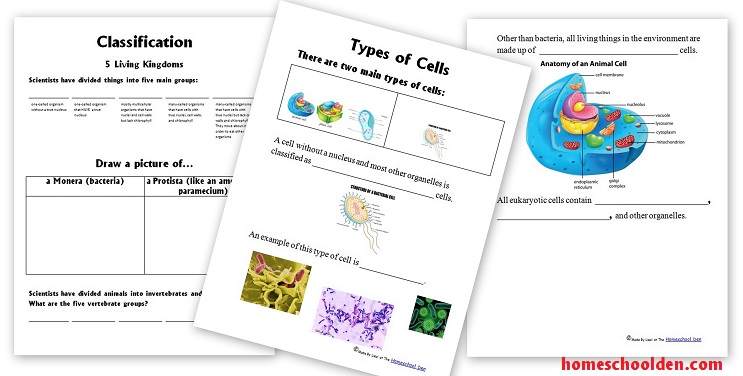
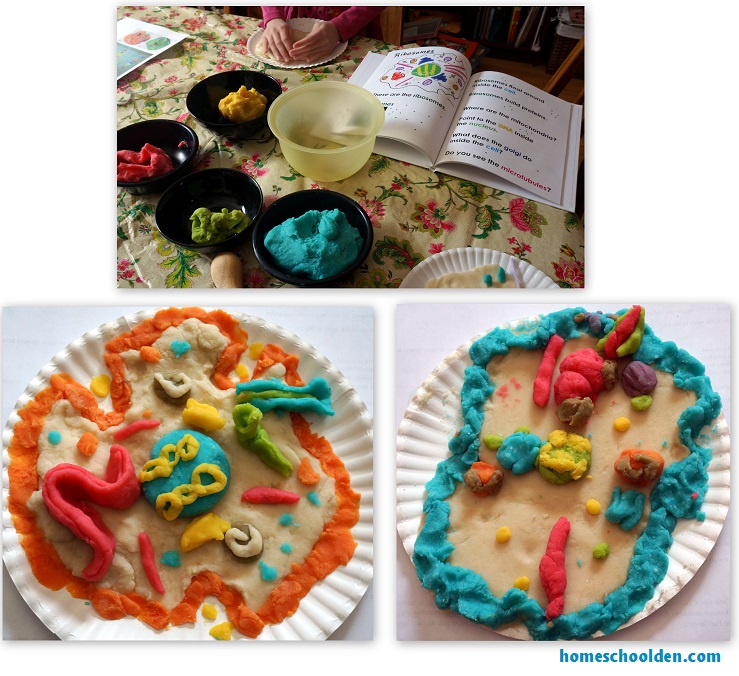
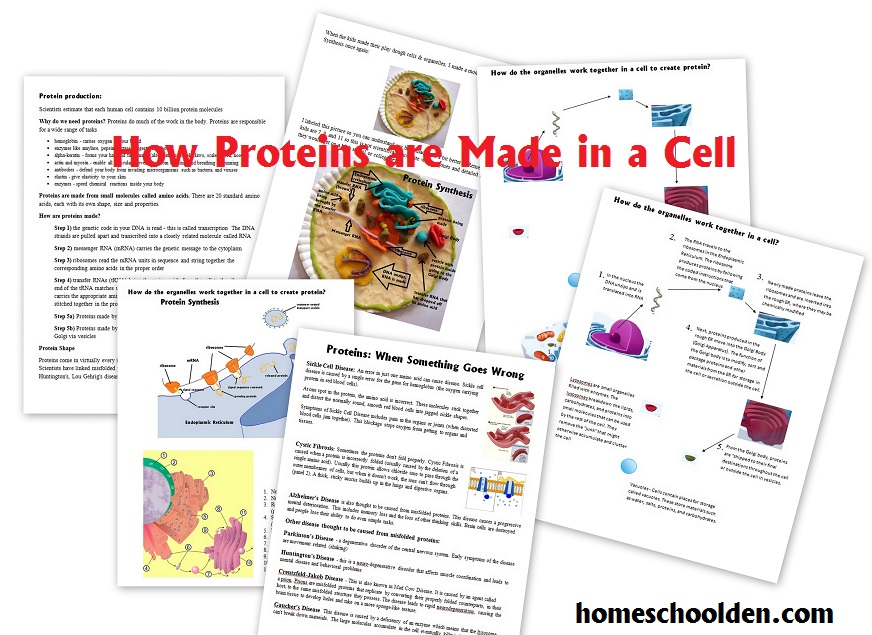



- red blood cells
- muscle cells
- nerve cells
- liver cells
- cardiac cells
- skin cells
When the kids were 9, 11 and 13 we reviewed the organelles of the cell again. I made some new review pages that cover the organelles and their functions:
New materials on Plant Cells and Photosynthesis:
Recently, we did a unit on plant cells and photosynthesis and created more than 50 new pages of worksheets and notebook pages. I’ve added this new material (as a separate PDF) to this unit!

Our packets are PDF digital downloads. After your purchase, remember to check your PayPal email address for the download link. This page answers some Frequently Asked Questions. You will receive 2 PDFs in a zipped file. If you have trouble opening the zipped file or if you have any questions, please email me! ~Liesl
Again, the Cell Packet is included in our Human Body Bundle. It is also included in the Biology Bundle of 6. For example, if you want to go on to study bacteria and viruses in more depth you might be interested in the (100-page) Pathogens Packet.
A Study of Cells Packet: $8.99
The download link will be sent to your PayPal email address.
Some years, we continued on from this unit to talk about human cells (then tissues, organs, systems). You can see more about that unit here: Human Body Systems: Cells, Tissues, Organs, Systems
View the Human Body BUNDLE here: Human Body Bundle Page or in Our Store.
![]() $42.99 Human Body BUNDLE OPTION 2: Human Body Systems, A Study of Cells Unit, Skeletal System Packet, Digestive System, Circulatory System Unit, Muscular System Packet, Nervous System Packet, Endocrine System, Reproductive System Worksheets (We often talked about cells as we started our Human Body Units… then went on to talk about human body cells, tissues, organs & systems… and then would move on to a different body system each year. Generally as homeschoolers, we covered just one or two major body systems each year before moving on to another science topic.) (Does not include the Five Senses Unit.) Visit this page Human Body Bundle Page for the other BUNDLE options are for lots more details and pictures of each of these units!
$42.99 Human Body BUNDLE OPTION 2: Human Body Systems, A Study of Cells Unit, Skeletal System Packet, Digestive System, Circulatory System Unit, Muscular System Packet, Nervous System Packet, Endocrine System, Reproductive System Worksheets (We often talked about cells as we started our Human Body Units… then went on to talk about human body cells, tissues, organs & systems… and then would move on to a different body system each year. Generally as homeschoolers, we covered just one or two major body systems each year before moving on to another science topic.) (Does not include the Five Senses Unit.) Visit this page Human Body Bundle Page for the other BUNDLE options are for lots more details and pictures of each of these units!
Biology BUNDLE OPTIONS:
Our units are PDF digital downloads.
Visit this Biology Bundle Page for more details (and lots more pictures!)
$44.99 Biology BUNDLE of 7: 1) Biology Unit (Biomes, habitats, food chains/webs, feeding relationships) 2) Scientific Classification & Taxonomy Packet 3) Ocean Unit & Layers of the Ocean/Ocean Zone Activities 4) Cells Unit 5) Botany Unit 6) Pathogens Unit – Bacteria, Protozoa, Fungi, Parasites/worms; Viruses and Prions 7) New! The Cell Cycle and Mitosis
Again, you can see the Biology BUNDLE Page for lots more pictures!
Don’t forget to check your PayPal email address for the download link from SendOwl (the delivery service I use)!
$8.99 Biology Unit: Biomes, habitats, ecosystem, biological interactions, feeding relationships (170 pages)
$8.99 Cells Unit (150+ pages) – cell theory, prokaryotic vs. eukaryotic cells, animal vs. plant cells, organelles of the cell, chloroplast anatomy, the layers of a leaf, photosynthesis and more.
$7.99 Botany Packet — (80 pages) Plant Classification, Life Cycle of the Moss, Fern, Conifer, Angiosperms, Parts of a Flower, Parts of a Seed, Seed & Fruit Development, Monocots vs Dicots – plus Carnivorous Plants Mini-Unit
$8.99 Ocean Unit – Layers of the Ocean/Ocean Zone: (100+ pages) Marine Habitats, Coral Reefs, Tide Pools, Water Form Words, Ocean navigation, Features of the ocean floor, salinity, ocean tides & currents, ocean life, bioluminescence & more!
$7.99 Scientific Classification and Taxonomy Packet (100 pages) dichotomous key activity, Linnaeus & the history of classification, learn the Animalia phyla (Annelids, Platyhelminthes, Nematodes, Cnidaria, Animalia, etc.)
$8.99 Pathogens Packet (100 pages) – This unit covers the six major living and nonliving pathogens: bacteria, protozoa, fungi and parasites/worms as well as viruses and prions. The large majority of this packet goes into detail about bacteria and viruses.
$5.99 The Cell Cycle and Mitosis Packet (50+ pages) – This unit covers topics/terms such as cell division, cell death (apoptosis), nucleosomes, histones, binary fission, chromatin, chromosomes, centromere, sister chromatids, and the lifespan of human cells as well as the stages of the cell cycle including interphase (G1, S, G2) and mitosis (prophase, anaphase, metaphase, telophase, cytokinesis)
Again, you can see the Biology BUNDLE Page for lots more pictures!
Be sure to check your PayPal email address for the download link!
Don’t forget to check your PayPal email address for the download link. Feel free to email me if you need help! ~Liesl
See you again soon here or over at our Homeschool Den Facebook Page! Don’t forget to Subscribe to our Homeschool Den Newsletter. You might also want to check out some of our resources pages above (such as our Science, Language Arts, or History Units Resource Pages) which have links to dozens of posts. You might want to join our free Homeschool Den Chat Facebook group. Don’t forget to check out Our Store as well. ~Liesl

Helpful videos:
This video, Introduction to Cells, was made by a science teacher I know, Frank Gregorio:
And this video is really helpful if you plan to introduce your kids/students to the production of proteins in the ribosomes:
My kids were 9 and 11 when we first did this unit (of course, my 7 year old joined in!). Last year we went over leaves, the layers of the leaf, and so forth (when the kids were 9, 11 and 14). And this year, we’ll be going over the organelles in much more detail (the kids are 10, 12, and 15) because my son is doing high school biology. As you can see, we tend to circle around and do our unit studies every few years. We go into more depth (or cover slightly different things) the next time around.
Here is a quick look at some of the worksheets, notebook pages and activities in the Cell Packet. Then I’ll go into more detail about the material below.
Cell Unit Activities and Worksheets:
First, we learned the basic parts of the cell:
- nucleus
- DNA
- centrioles
- lysosomes
- mitochondria
- microtubules
- ribosomes
- Golgi apparatus
- vesicles
- cell membrane
- cytoplasm
- Endoplasmic reticulum
Here is DD showing us the parts of the cell in the play dough model she made! She talks rather quickly, but you get the idea! (She was 9 at the time.) ?
How did DD learn all this? We read through April Terrazas’s book Cellular Biology: Organelles, Structure, Function (This is an affiliate link.) and by the end of the week (going through the book once each day), the kids knew the basic functions COLD!! Lysosomes are the “trash can” of the cell… I *highly* recommend her book!
Note: the book doesn’t include the Endoplasmic reticulum, which we definitely need to know when we went on to learn about how proteins are made. Still, it was such a powerful teaching tool. I don’t know if we could have covered the basic organelles any easier than by using her book! We also started reading Learning About Cells and Cell Function and Specialization. 

Prokaryotes vs. Eukaryotes: The kids really loved our microscope work examining the differences between prokaryotes and eukaryotes. We have a microscope and pulled out prepared slides of the skin of a pumpkin, a paramecium, and bacteria. (We have this Prepared Slide Set – Intermediate which is available at Amazon — Affiliate Link). The kids drew pictures of what they saw. Then we talked again in great detail about the differences between prokaryotes (bacteria) and eukaryotes (plants, animals, protozoa, etc.) 





- red blood cells
- muscle cells
- nerve cells
- liver cells
- cardiac cells
- skin cells
When the kids were 9, 11 and 13 we reviewed the organelles of the cell again. I made some new review pages that cover the organelles and their functions:
New materials on Plant Cells and Photosynthesis:
Recently, we did a unit on plant cells and photosynthesis and created more than 50 new pages of worksheets and notebook pages. I’ve added this new material (as a separate PDF) to this unit!

Our packets are PDF digital downloads. After your purchase, remember to check your PayPal email address for the download link. This page answers some Frequently Asked Questions. You will receive 2 PDFs in a zipped file. If you have trouble opening the zipped file or if you have any questions, please email me! ~Liesl
Again, the Cell Packet is included in our Human Body Bundle. It is also included in the Biology Bundle of 6. For example, if you want to go on to study bacteria and viruses in more depth you might be interested in the (100-page) Pathogens Packet.
A Study of Cells Packet: $8.99
The download link will be sent to your PayPal email address.
Some years, we continued on from this unit to talk about human cells (then tissues, organs, systems). You can see more about that unit here: Human Body Systems: Cells, Tissues, Organs, Systems
View the Human Body BUNDLE here: Human Body Bundle Page or in Our Store.
![]() $42.99 Human Body BUNDLE OPTION 2: Human Body Systems, A Study of Cells Unit, Skeletal System Packet, Digestive System, Circulatory System Unit, Muscular System Packet, Nervous System Packet, Endocrine System, Reproductive System Worksheets (We often talked about cells as we started our Human Body Units… then went on to talk about human body cells, tissues, organs & systems… and then would move on to a different body system each year. Generally as homeschoolers, we covered just one or two major body systems each year before moving on to another science topic.) (Does not include the Five Senses Unit.) Visit this page Human Body Bundle Page for the other BUNDLE options are for lots more details and pictures of each of these units!
$42.99 Human Body BUNDLE OPTION 2: Human Body Systems, A Study of Cells Unit, Skeletal System Packet, Digestive System, Circulatory System Unit, Muscular System Packet, Nervous System Packet, Endocrine System, Reproductive System Worksheets (We often talked about cells as we started our Human Body Units… then went on to talk about human body cells, tissues, organs & systems… and then would move on to a different body system each year. Generally as homeschoolers, we covered just one or two major body systems each year before moving on to another science topic.) (Does not include the Five Senses Unit.) Visit this page Human Body Bundle Page for the other BUNDLE options are for lots more details and pictures of each of these units!
Biology BUNDLE OPTIONS:
Our units are PDF digital downloads.
Visit this Biology Bundle Page for more details (and lots more pictures!)
$44.99 Biology BUNDLE of 7: 1) Biology Unit (Biomes, habitats, food chains/webs, feeding relationships) 2) Scientific Classification & Taxonomy Packet 3) Ocean Unit & Layers of the Ocean/Ocean Zone Activities 4) Cells Unit 5) Botany Unit 6) Pathogens Unit – Bacteria, Protozoa, Fungi, Parasites/worms; Viruses and Prions 7) New! The Cell Cycle and Mitosis
Again, you can see the Biology BUNDLE Page for lots more pictures!
Don’t forget to check your PayPal email address for the download link from SendOwl (the delivery service I use)!
$8.99 Biology Unit: Biomes, habitats, ecosystem, biological interactions, feeding relationships (170 pages)
$8.99 Cells Unit (150+ pages) – cell theory, prokaryotic vs. eukaryotic cells, animal vs. plant cells, organelles of the cell, chloroplast anatomy, the layers of a leaf, photosynthesis and more.
$7.99 Botany Packet — (80 pages) Plant Classification, Life Cycle of the Moss, Fern, Conifer, Angiosperms, Parts of a Flower, Parts of a Seed, Seed & Fruit Development, Monocots vs Dicots – plus Carnivorous Plants Mini-Unit
$8.99 Ocean Unit – Layers of the Ocean/Ocean Zone: (100+ pages) Marine Habitats, Coral Reefs, Tide Pools, Water Form Words, Ocean navigation, Features of the ocean floor, salinity, ocean tides & currents, ocean life, bioluminescence & more!
$7.99 Scientific Classification and Taxonomy Packet (100 pages) dichotomous key activity, Linnaeus & the history of classification, learn the Animalia phyla (Annelids, Platyhelminthes, Nematodes, Cnidaria, Animalia, etc.)
$8.99 Pathogens Packet (100 pages) – This unit covers the six major living and nonliving pathogens: bacteria, protozoa, fungi and parasites/worms as well as viruses and prions. The large majority of this packet goes into detail about bacteria and viruses.
$5.99 The Cell Cycle and Mitosis Packet (50+ pages) – This unit covers topics/terms such as cell division, cell death (apoptosis), nucleosomes, histones, binary fission, chromatin, chromosomes, centromere, sister chromatids, and the lifespan of human cells as well as the stages of the cell cycle including interphase (G1, S, G2) and mitosis (prophase, anaphase, metaphase, telophase, cytokinesis)
Again, you can see the Biology BUNDLE Page for lots more pictures!
Be sure to check your PayPal email address for the download link!
Don’t forget to check your PayPal email address for the download link. Feel free to email me if you need help! ~Liesl
See you again soon here or over at our Homeschool Den Facebook Page! Don’t forget to Subscribe to our Homeschool Den Newsletter. You might also want to check out some of our resources pages above (such as our Science, Language Arts, or History Units Resource Pages) which have links to dozens of posts. You might want to join our free Homeschool Den Chat Facebook group. Don’t forget to check out Our Store as well. ~Liesl

Helpful videos:
This video, Introduction to Cells, was made by a science teacher I know, Frank Gregorio:
And this video is really helpful if you plan to introduce your kids/students to the production of proteins in the ribosomes:


